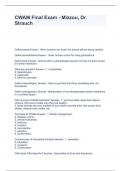Define domesticated Study guides, Class notes & Summaries
Looking for the best study guides, study notes and summaries about Define domesticated? On this page you'll find 60 study documents about Define domesticated.
Page 2 out of 60 results
Sort by
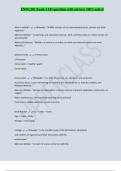
-
ENWC201 Exam 1 UD questions with answers 100% solved
- Exam (elaborations) • 13 pages • 2024
- Available in package deal
-
- $17.49
- + learn more
ENWC201 Exam 1 UD questions with answers 100% solved What is wildlife? Wikipedia: "Wildlife includes all non‐domesticated plants, animals and other organisms." Merriam‐Webster: "Living things and especially mammals, birds, and fishes that are neither human nor domesticated" Bolen and Robinson: "Wildlife is a hard term to define, but birds and mammals receive the most attention..." Gifford Pinchot x Preservation x Protection Conservator ‐> together guard Conservation ...
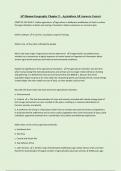
-
AP Human Geography Chapter 9 – Agriculture All Answers Correct
- Exam (elaborations) • 13 pages • 2024
-
- $10.49
- + learn more
AP Human Geography Chapter 9 – Agriculture All Answers Correct START OF KEY ISSUE 1: Define agriculture Agriculture is deliberate modification of Earth's surface through cultivation of plants and rearing of animals to obtain sustenance or economic gain. Define cultivate Define crop To care for; to prepare crops for farming. Any plant cultivated by people Why is the exact origin of agriculture hard to determine? It began before recorded history; scholars try to reconstr...
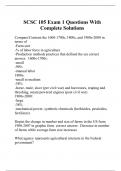
-
SCSC 105 Exam 1 Questions With Complete Solutions
- Exam (elaborations) • 11 pages • 2023
-
Available in package deal
-
- $11.49
- + learn more
Compare/Contrast the s, 1800s, and 1900s-2000 in terms of -Farm size -% of labor force in agriculture -Production methods practices that defined the era correct answer: 1600s-1700s: -small -90% -manual labor 1800s: -small to medium -58% -horse, mule, slave (pre civil war) and harvestors, reaping and threshing, steam powered engines (post civil war) 1900s-2000: -large -38% -mechanical power, synthetic chemicals (herbicides, pesticides, fertilizers) Depict the change in number...
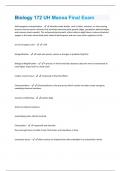
-
Biology 172 UH Manoa Final Exam Questions + Answers Graded A+
- Exam (elaborations) • 10 pages • 2024
- Available in package deal
-
- $7.99
- + learn more
Anthropogenic eutrophication - whereby water bodies, such as lakes, estuaries, or slow-moving streams receive excess nutrients that stimulate excessive plant growth (algae, periphyton attached algae, and nuisance plants weeds). This enhanced plant growth, often called an algal bloom, reduces dissolved oxygen in the water when dead plant material decomposes and can cause other organisms to die arrival of captain cook - 1778 bimagnification - small eats poison, poison is stronger in predator ...
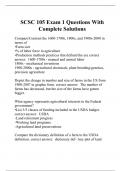
-
SCSC 105 Exam 1 Questions With Complete Solutions
- Exam (elaborations) • 10 pages • 2023
-
Available in package deal
-
- $10.99
- + learn more
Compare/Contrast the s, 1800s, and 1900s-2000 in terms of •Farm size •% of labor force in agriculture •Production methods practices that defined the era correct answer: s - manual and animal labor 1800s - mechanical inventions s - agricultural chemicals, plant breeding/genetics, precision agriculture Depict the change in number and size of farms in the US from in graphic form. correct answer: The number of farms has decreased, but the size of the farms have gotten bigger. Wha...
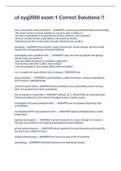
-
uf syg2000 exam 1 Correct Solutions
- Exam (elaborations) • 13 pages • 2023
-
- $12.49
- 1x sold
- + learn more
empirical research and social theory - ANSWER -theories are statements regarding how facts are related to each other and the connections between them -the level of analysis and theory help determine the method used to measure the social phenomena sociology's major theoretical perspectives - ANSWER -guides sociologists' ideas and research -helps them understand social behavior -helps develop explanations of organized social patterns and their relationships -can be micro- or macro- level ...
CWAM Final Exam - Mizzou, Dr. Strauch
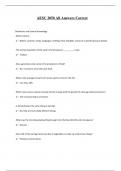
-
AESC 2050 All Answers Correct
- Exam (elaborations) • 12 pages • 2024
-
Available in package deal
-
- $10.49
- + learn more
AESC 2050 All Answers Correct Definitions and General Knowledge - Define Culture: ️ Beliefs, customs, rituals, languages, clothing, food, thoughts, values of a specific group of people. - The human population of the earth recently passed __________ mark: ️ 7 billion. - Does agriculture only concern the production of food? ️ No, it concerns more than just food. - What is the average annual % of income spent on food in the US? ️ Less than 10%. - Which new human cultural c...
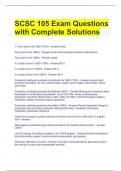
-
SCSC 105 Exam Questions with Complete Solutions
- Exam (elaborations) • 7 pages • 2023
-
Available in package deal
-
- $12.49
- + learn more
SCSC 105 Exam Questions with Complete Solutions . Farm size in the 's - Answer-small Farm size in the 1800's - Answer-small-med (exception southern plantations) Farm size in the 1900's - Answer-Large % of labor force in 's - Answer-90 % % of labor force in 1800's - Answer-58 % % of labor force in the 1900's - Answer-38 % Production methods practices that defined the 's - Answer-manual labor, primarily hand labor, ax, hoe, shovel sickle, scythe, grain cradle, animal lab...

-
SOLUTIONS AND PROBLEM SOLVING MANUAL FOR GENETICS ESSENTIALS CONCEPTS AND CONNECTIONS THIRD EDITION By PIERCES TEST BANK
- Exam (elaborations) • 283 pages • 2024
-
- $26.49
- + learn more
1. How did the Hopi culture contribute to the high incidence of albinism among members of the Hopi tribe? Solution: In the Hopi culture, albino individuals were considered special and awarded special status in the village. Hopi male albinos were not required to work the fields, thus avoiding extensive exposure to sunlight that could prove damaging or deadly. Albinism was considered a positive trait and not a negative physical condition, which allowed albinos to have more children, increas...

How did he do that? By selling his study resources on Stuvia. Try it yourself! Discover all about earning on Stuvia



